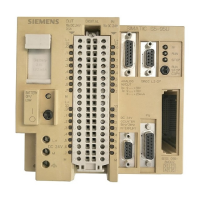Notes on Controller Settings
IP244
C79000–B8576–C860–02
4–124
Most controller systems are so-called self-regulating systems (see Fig. 4.1/1). The dynamic
response can be approximated by the variables delay time T
u
, response time T
g
and maximum
value X
max
. These values are determined by placing a tangent to the response curve which
intersects the maximum and minimum values. The transient response must in many cases not be
allowed to reach the maximum value, since the controlled variable must not exceed certain values.
The rate of rise v
max
is therefore used to define the controlled system.
From the ratio
T
u
T
g
or
T
u
v
max
X
max
the controllability of the system
can be estimated.
The
following
applies:
T
u
T
g
< 0.1 can be controlled well
0.1 to 0.3 is controllable
> 0.3 difficult to control
Systems can be evaluated according to the following values:
T
u
< 0.5 min, T
g
< 5 min = fast controlled system
T
u
> 0.5 min, T
g
> 5 min = slow controlled system
Characteristic values of important temperature-controlled systems
Temperature Small, electrically heated
oven/kiln 0.5 to 1 min 5 to 15 min to 60 K/min
Large, electrically heated
annealing furnace 1 to 5 min 10 to 20 min to 20 K/min
Large, gas heated
annealing furnace 0.2 to 5 min 3 to 60 min 1 K /min to 30 K/min
Autoclave system 0.5 to 0.7 min 10 to 20 min
High pressure autoclave system 12 to 15 min 200 to 300 min
Injection molding machines 0.5 to 3 min 3 to 30 min 5 K /min to 20 K/min
Extruders 1 to 6 min 5 to 60 min
Packaging machines 0.5 to 4 min 3 to 40 min 2 K /min to 35 K/min
Controlled Type of controlled system Delay time Response time Rate of rise
variable T
u
T
g
V
max
4.2 Controller Type (2-step, 3-step controllers)
2-step controller without feedback
2-step controllers have the switching states ”ON” and ”OFF”. This corresponds to 100% or 0%
power. This action produces a continuous oscillation of the controlled variable x round the
setpoint w.
The amplitude and the period of oscillation increases with the ratio of delay time (T
u
) to response
time T
g
of the controlled system and with the hysteresis X
Sd
of the controller. These controllers are
mainly used for simple temperature controls, e.g. electric directly heated ovens or as limit value
detectors.

